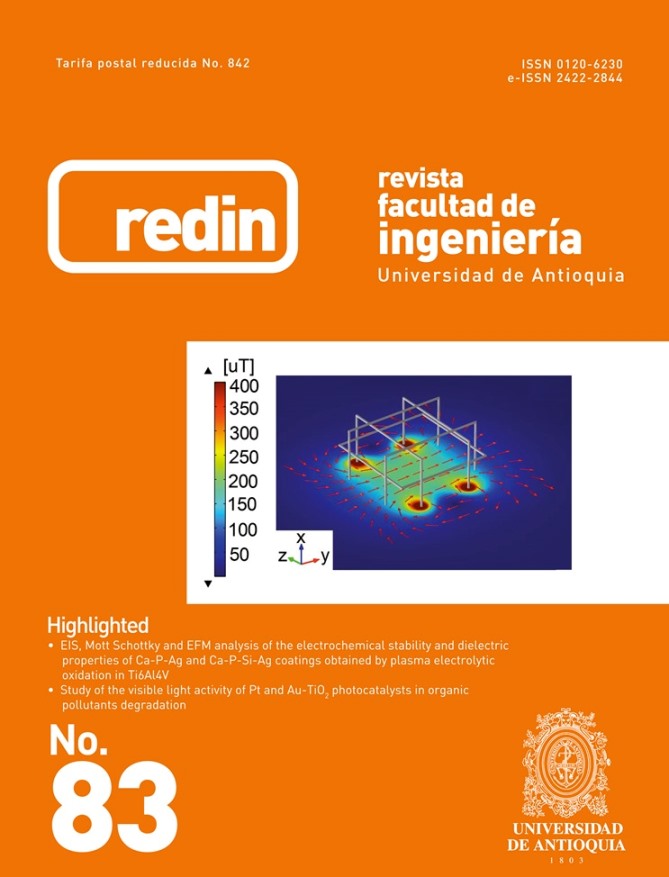Recycling rotating electrical machines
DOI:
https://doi.org/10.17533/udea.redin.n83a07Keywords:
recycling, standards, rotating electrical machines, induction motors, synchronous machinesAbstract
This paper establishes design principles for rotating recyclable electrical machines (synchronous and induction), in other words electrical machines and machine components may be reused. Also, technological issues arising from following machine components are covered: stator core, rotor core, stator windings, rotor windings, bearings, shafts, and frames. Design principles discussed may be extended to transformers. Insulation materials in high voltage windings are not considered. This paper did not consider economic advantages of the processes, neither environmental consequences. Rotating machines considered in the present study are of a power range within 0.1 kW to 400 kW, frequencies 50 hertz and 60 hertz and poles 2, 4 and 6 although the general concepts could be applied to other machines. Required machine standards to achieve these goals are discussed, covering: speed, nominal voltage, capacities, shapes, dimensions, insulation, cores, windings, bearings, shafts and frames.
Downloads
References
R. Hernández, J. Salinas, and J. R. Pacheco, “Design principles for recycling large electric machinery,” in International Conference on Electrical Machines (ICEM), Espoo, Finland, 2000, pp. 1679-1682.
European Parliament, Council of the European Union, Directive 2012/19/EU of the European Parliament and of the Council of 4 July 2012 on waste electrical and electronic equipment (WEEE), 2012. [Online]. Available: https://goo.gl/QIBg1c. Accessed on: Apr. 15, 2016.
M. O'Connell, C. Fitzpatrick, and S. Hickey, “WEEE Reuse Trials in Ireland,” in IEEE International Symposium on Sustainable Systems and Technology (ISSST), Chicago, USA, 2011, pp. 1-6.
C. Moskowitz, Florida Spaceport Gets Upgrade for New Rocket [Slide Show], 2014. [Online]. Available: https://goo.gl/ATtK7e. Accessed on: Apr. 19, 2016.
IEEE, IEEE Standard for the Repair and Rewinding of AC Electric Motors in the Petroleum, Chemical, and Process Industries, IEEE Standard 1068, 2009.
R. C. Creese, Introduction to manufacturing processes and materials, 1st ed. Morgantwon, USA: CRC Press, 1999.
A. Porteous, Dictionary of Environmental Science and Technology, 4th ed. Chichester, UK: John Wiley & Sons, 2008.
A. Lambert and S. M. Gupta, Disassembly Modeling for Assembly, Maintenance, Reuse and Recycling, 1st ed. Boca Raton, USA: CRC Press, 2005.
British Standards Institution (BSI), Design for manufacture, assembly, disassembly and end-of-life processing (MADE). The process of remanufacture, Specification, BSI Standard 8887-220, 2010.
W. L. Ijomah, “A model-based definition of the generic remanufacturing business process,” Ph.D. dissertation, University of Plymouth, Plymouth, UK, 2002.
R. Hernández, J. Salinas, and J. R. Pacheco, “Design principles for recycling induction motors,” in IEEE International Electric Machines and Drives Conference (IEMDC), Cambridge, USA, 2001, pp. 782-788.
Z. Godec, “Aging of grain-oriented electrical steel strips,” IEEE Transactions on Magnetics, vol. 14, no. 1, pp. 9-13, 1978.
K. Baba et al., “Hitachi’s Involvement in Material Resource Recycling,” Hitachi Review, vol. 59, no. 4, pp. 180-187, 2010.
S. T. Lundmark and M. Alatalo, “A segmented claw-pole motor for traction applications considering recycling aspects,” in 8th International Conference and Exhibition on Ecological Vehicles and Renewable Energies (EVER), Monte Carlo, Monaco, 2013, pp. 1-6.
J. Pyrhonen, T. Jokinen, and V. Hrabovcova, Design of Rotating Electrical Machines, 2nd ed. New York, USA: John Wiley & Sons, 2013.
International Electrotechnical Commission (IEC), Dimensions and output series for rotating electrical machines - Part 1: Frame numbers 56 to 400 and flange numbers 55 to 1080, Standard IEC 60072-1, 1991.
International Electrotechnical Commision (IEC), Dimensions and output series for rotating electrical machines - Part 2: Frame numbers 355 to 1000 and flange numbers 1180 to 2360, Standard IEC 60072-2, 1990.
International Electrotechnical Commision (IEC), Dimensions and output series for rotating electrical machines - Part 3: Small built-in motors - Flange numbers BF10 to BF50, Standard IEC 60072-3, 1994.
National Electrical Manufacturers Association (NEMA), Motors and Generators, Standard NEMA MG-1, 2011.
Z. Li, Why we need a new motor design suited for magnets recycling?, 2016. [Online]. Available: https://goo.gl/ETJVFz. Accessed on: Mar. 11, 2016.
M. Xiangru, Z. Yongjie, and S. Wei, “Network Construction on Reverse Logistics of Discarded and Used Household Appliances,” in International Conference on Environmental Science and Information Application Technology, Wuhan, China, 2009, pp. 108-111.
J. D. Widmer, R. Martin, and M. Kimiabeigi, “Electric vehicle traction motors without rare earth magnets,” Sustainable Materials and Technologies, vol. 3, pp. 7-13, 2015.
Downloads
Published
How to Cite
Issue
Section
License
Copyright (c) 2017 Revista Facultad de Ingeniería

This work is licensed under a Creative Commons Attribution-NonCommercial-ShareAlike 4.0 International License.
Revista Facultad de Ingeniería, Universidad de Antioquia is licensed under the Creative Commons Attribution BY-NC-SA 4.0 license. https://creativecommons.org/licenses/by-nc-sa/4.0/deed.en
You are free to:
Share — copy and redistribute the material in any medium or format
Adapt — remix, transform, and build upon the material
Under the following terms:
Attribution — You must give appropriate credit, provide a link to the license, and indicate if changes were made. You may do so in any reasonable manner, but not in any way that suggests the licensor endorses you or your use.
NonCommercial — You may not use the material for commercial purposes.
ShareAlike — If you remix, transform, or build upon the material, you must distribute your contributions under the same license as the original.
The material published in the journal can be distributed, copied and exhibited by third parties if the respective credits are given to the journal. No commercial benefit can be obtained and derivative works must be under the same license terms as the original work.










 Twitter
Twitter